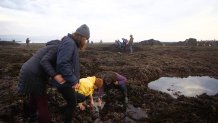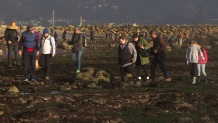On a recent day at Pillar Point in Half Moon Bay, the waters of a King Tide retreated, yielding to an extreme low tide that revealed a craggy reef -- which in turn drew dozens of visitors to explore its bountiful tide pools.
Among the throngs of visitors attracted to the somewhat rare conditions, Rebecca Johnson and Alison Young -- researchers with Cal Academy of Science -- led a group of citizen scientists to search the area for a specific sea creature -- sea stars aka starfish.
The informal expedition was to get a status update on sea stars, following their battle with a strange disease that touched off a domino effect of calamity in the eco-system.
"When they’re missing," said Johnson, "it kind of throws off all these other relationships in that food web."
Get a weekly recap of the latest San Francisco Bay Area housing news. Sign up for NBC Bay Area’s Housing Deconstructed newsletter.
On this day, the volunteers' assignment was to locate any sea stars, photograph them, and upload the images to the INaturalist app -- an online data bank for scientific research. Although Young and Alison have researched the area for a decade, the extra help was aimed at giving a more complete look at the picture.
"They’re a really key species in the health of tidal eco-system," said Young, "so we’re hoping to get as many eyes out here to see if we can find some of those species that are potentially not recovering as well."
The group traversed the slippery, sea weed covered rocks -- peering into the seawater-filled crevices taking in the abundant sea life. Small snail shells repurposed by hermit crabs flitted past pale-colored sea anemones, small nudibranch sea slugs slithered beneath dense clumps of mussels.

But the real finds, at least on this occasion, were the sightings of ochre and maroon-colored sea stars contorted into a myriad of shapes clinging to the rocks. The species is still slowly recovering from a mysterious wasting disease that coincided with the arrival in 2014 of an usual warm patch of water, nicknamed the warm blob -- a strange anomaly scientists linked to climate change.
Local
"People started noticing starfish, sea stars," Young said, "that would start to develop these white lesions on their body, and then they would basically disintegrate."
The demise of sea stars allowed their prey, purple sea urchins, to populate unchecked. The armies of purple urchins wiped out kelp forests along the north coast which in turn decimated the population of abalone dependent on kelp. It was a chain reaction illustrating nature's fragile balance.
"If they come back," said Johnson, "they really will bring balance back to our coastal eco-systems because these were predators that ate lots of different species."
But the sea star's return is still a work in progress. The recent outing was only geared toward gathering a bit of evidence of how far that recovery has progressed. The extra sets of eyes scanning the reef for sea stars and logging their numbers was intended to serve as a waypoint in that journey.
While there were plenty of common ochre stars to be found, the researchers were also hoping to find other species which remain impacted by the wasting disease -- especially the elusive sunflower star -- the chief predator of sea stars. The search did yield a pair of leather stars, identified by their blotchy tan and white appearance.

"They say if you rub it," Johnson informed, "it smells like garlic."
Another significant discovery was a bat star, named for its batwing shaped arms. It would take Johnson's experienced eye to also spot a six ray star, a six-armed sea star about the diameter of a quarter.
By the end of the outing, the group would record five different sea star species, with no signs of the wasting disease, but also no sign of the sought-after sunflower star. While encouraged by their findings, Young cautioned against taking away too much from the day's anecdotal evidence.
"Depending on where you are things might seem back to normal," Young said "or not back to normal depending on which species are there."
Young and Johnson have studied the Pillar Point reef over the last decade, venturing out at extreme low tides to keep tabs on the sea creatures that make it home. The low tide is an extreme counterpoint as the area is also known for its extreme waves, home to the world famous Mavericks surfing spot. The contrast makes the low tides seem even more special, drawing researchers, families, and visitors harvesting mussels and urchin.
"You just need a pair of boots and you can see almost every phylum of life on earth," said Johnson. "Maybe in like a square foot."
From their repeated visits, Johnson and Young believe the sea stars are recovering, and will hopefully get back to their devouring of purple urchins, restoring the balance in nature.
"The hope is they are actually still out there," said Young as the sun began setting on the scene. "What we need is everybody out searching so we can hopefully find them."



